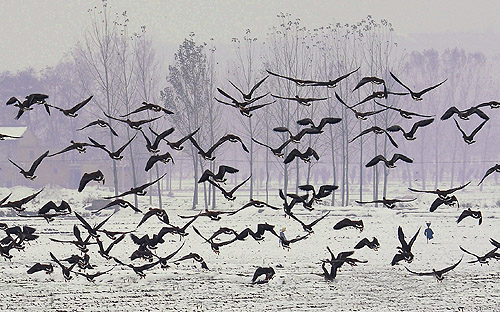|
 |
|
CHEERFUL PLACE: Wild geese come to the Yellow River Wetland Reserve in Mengjin, central China's Henan Province, to pass the winter (WANG SONG) | "Today, China has made great progress in strategic planning, scientific research and improving public awareness," Zhou said, adding that 85 percent of natural ecosystem types, 47 percent of natural wetlands, 20 percent of natural forests and 65 percent of higher flora communities in the country have been protected. Also under this protection umbrella are most of China's recognized natural heritage and endangered wildlife.
Despite this, Zhou said the habitats of some important species are facing threats and loss of genetic resources. He said that now the Ministry of Environmental Protection is considering to revise the China Biological Diversity Protection Action Plan and publish the China Biological Diversity Protection Strategy and Action Plan, taking the opportunity of the International Year of Biodiversity.
According to him, the revised Protection Strategy and Action Plan would confirm 34 priority protection areas, set out the approach and guiding principles for China's biodiversity conservation from 2010 to 2030 as well as short-, medium- and long-term tasks.
"Biodiversity is the 'immune system of the Earth' and wetlands, natural ecological systems containing a great spread of biodiversity are the 'kidney of the earth.' They play a pivotal role in sustaining the whole function of the land's ecological systems," said Jia Zhibang, Minister of the State Forestry Administration of China.
He said that a national wetland protection network is being formed. In wetland areas, "China has built more than 550 natural reserves, 100 national parks and 37 important international wetlands, in which 50 percent of natural wetlands and a large number of endangered species are under protection," Jia said.
Work of NGOs
"Protection for biodiversity is facing a unprecedented opportunity today," said Lu Zhi, Director of Shanshui Conservation Center, an environmental NGO in China dedicated to biodiversity protection, who represented NGOs at the China action launch ceremony for International Year of Biodiversity.
Data from the 23rd International Conference for Conservation Biology held in Beijing last July showed there are 3,000 NGOs dedicated to environmental and species protection in China.
In the mid-1980s, Lu did a research in a secluded area of Qinling Mountain in northwest China's Shaanxi Province to research giant pandas. as a member of the Giant Panda and Wildlife Conservation Research Center at Peking University. "One day, a pregnant deer strayed into a village and was caught by a villager finally. A villager told me I could taste the meat of the deer. That shocked me," Lu said. "So I realized environmental protection needs supports from local people. Without that, there is nothing we can do."
"We should encourage cooperation between governments, NGOs and local communities. Public participation, cooperation and mutual understanding will make natural protection more efficient. As well, it will enable presently marginalized protection work to be better understood by the public," she said.
On May 12, 2008, a strong earthquake hit Sichuan Province. Its epicenter was in Wenchuan County, which is on the eastern edge of a key biodiversity area in China's southwest mountains. Data collected by the Giant Panda and Wildlife Conservation Research Center show luxuriant forest vegetation diffused damage to panda habitats as well as to people and their environment.
"This indicates protection of ecological environment has much meaning in relation to the safety of human life and properties," Lu said.
Liu Mingfu is the head of Chaping Village of Dujiangyan, Sichuan Province. He received a biodiversity training from a China-European Union project three months ago. Over the past months, he led villagers to record ecological resources around the village with pens and cameras. Recently, they published a guidebook, summarizing their research achievements.
"They discovered there are more than 2,000 plant species in the region, among which more than 200 were recorded in detail by villagers," Jia Lei, who was in charge of this research, said.
Although the word "biodiversity" is a new concept to most Chinese, loving life and being harmonious with nature are ongoing and are deeply rooted in Chinese culture. "The key to successful biodiversity protection is in public participation and wisdom," Lu said. | 